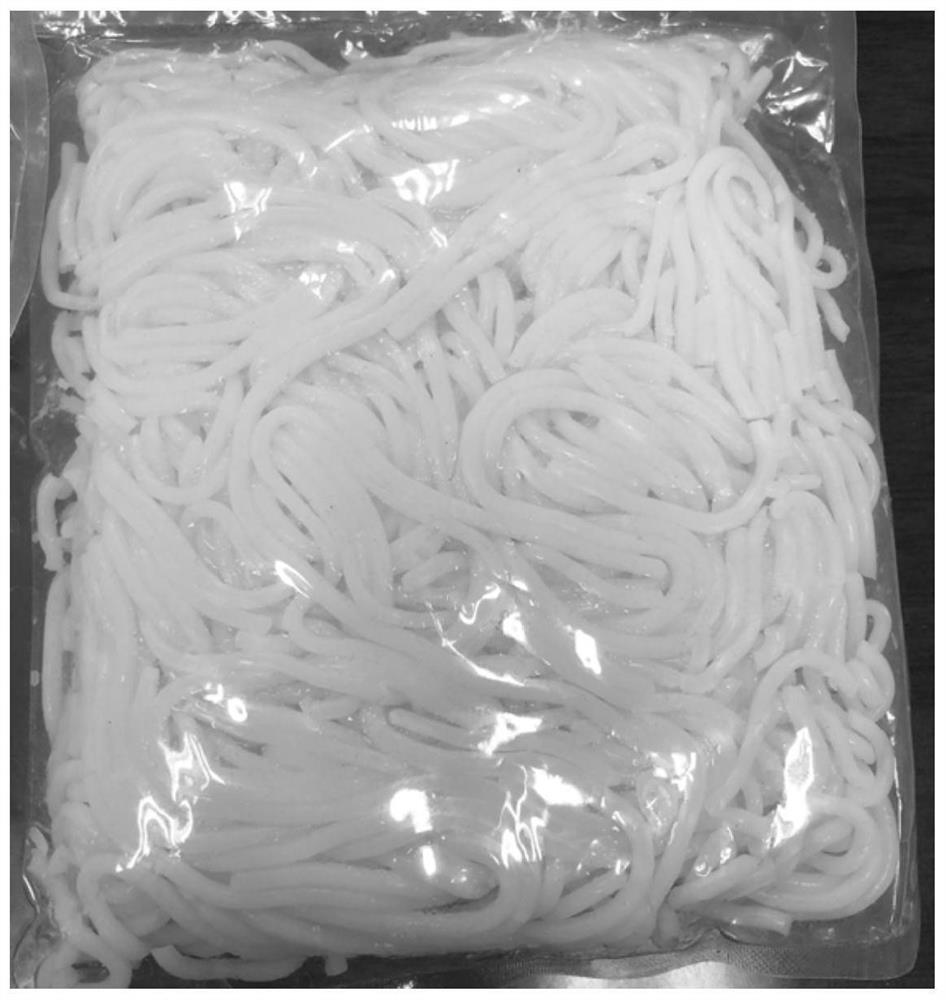Processing method of fresh wet rice noodles
A processing method and rice noodle technology, applied in food science, food ingredients, food drying, etc., can solve problems such as unbalanced amylose-amylopectin ratio, lack of toughness in taste, and decline in the quality of rice noodles
- Summary
- Abstract
- Description
- Claims
- Application Information
AI Technical Summary
Problems solved by technology
Method used
Image
Examples
Embodiment 1
[0049] Weigh 100kg of early indica rice, wash it, remove impurities, and drain; put the rice into water for 4 hours according to the ratio of rice to water mass of 1:2, add 3 times the quality of early indica rice to water after soaking, and grind it with a refiner Rice milk, grinding until there is no obvious feeling of sand; weigh 50kg cornstarch and add it to the above rice milk and mix it evenly, and the water balance time is 10min.
[0050] Put the mixed materials in a vacuum tank with a vacuum of -0.5bar and a temperature of 90°C for pre-curing. The curing time is 5s. After testing, the moisture content of the material after curing is 45% and the curing degree is 72.41%; The latter materials are further matured and dehydrated after flashing in the flashing tank. The flashing conditions are: pressure 0.08Mpa, temperature 85°C, flashing for 2 minutes. After testing: the moisture content of the material after flashing is 20%, and the maturation degree is 85.39%.
[0051] After ...
Embodiment 2
[0054] Weigh 100kg of early indica rice, wash, remove impurities, and drain; soak the rice in water for 4 hours according to a rice-water mass ratio of 1:3. After soaking, add water that is twice the quality of early indica rice and grind it into a rice slurry with a refiner , Grind until there is no obvious feeling of sand; weigh 40kg cornstarch and add it to the above rice milk and mix it evenly, and the water balance time is 15min.
[0055] The mixed materials are pre-cured in a vacuum tank with a vacuum of -0.1bar and a temperature of 95°C. The curing time is 5s. After testing, the moisture content of the cured material is 48% and the curing degree is 76.42%; the cured material The material is further matured and dehydrated after flashing in the flashing tank. The flashing conditions are: pressure 0.1Mpa, temperature 80°C, flashing for 2 minutes. After testing: the moisture content of the material after flashing is 26%, and the maturity is 89.22%.
[0056] After the flashing, ...
Embodiment 3
[0058] Weigh 100kg of early indica rice, wash, remove impurities, and drain; soak the rice in water for 4 hours according to the rice-water mass ratio of 1:2. After soaking, add water that is 3 times the quality of early indica rice and grind it with a refiner. , Grind until there is no obvious feeling of sand; weigh 20kg of corn starch and add it to the above rice milk and mix it evenly, and the water balance time is 10min.
[0059] The mixed materials are vacuum pre-cured and flash vaporized. The specific conditions are the same as those in Example 1. After testing, the water content of the flash vaporized materials is 32%, and the maturation degree is 80.18%.
[0060] After the flashing is finished, extrusion molding, packaging and sterilization, the specific conditions are the same as in Example 1; cooling to room temperature (about 25°C) is the finished product of fresh and wet rice noodles.
PUM
 Login to View More
Login to View More Abstract
Description
Claims
Application Information
 Login to View More
Login to View More - R&D
- Intellectual Property
- Life Sciences
- Materials
- Tech Scout
- Unparalleled Data Quality
- Higher Quality Content
- 60% Fewer Hallucinations
Browse by: Latest US Patents, China's latest patents, Technical Efficacy Thesaurus, Application Domain, Technology Topic, Popular Technical Reports.
© 2025 PatSnap. All rights reserved.Legal|Privacy policy|Modern Slavery Act Transparency Statement|Sitemap|About US| Contact US: help@patsnap.com



